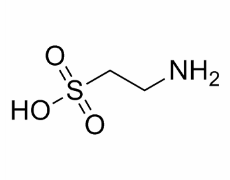
Taurine, or 2-aminoethanesulfonic acid, is an organic acid. It is a major constituent of bile and can be found in the lower intestine and, in small amounts, in the tissues of many animals, including humans. Taurine is a derivative of the sulfur-containing (sulfhydryl) amino acid cysteine. Taurine is one of the few known naturally occurring sulfonic acids. Taurine has the ability to activate autophagy in adipocytes. Taurine is one of the most abundant amino acids in the brain and spinal cord, leukocytes, heart and muscle cells, the retina, and indeed almost every tissue throughout the body.
| Molecular Weight | 125.15 |
| Formula | C2H7NO3S |
| CAS Number | 107-35-7 |
| Solubility (25°C) | Water 20 mg/mL |
| Storage |
Powder -20°C 3 years ; 4°C 2 years In solvent -80°C 6 months ; -20°C 1 month |
| Species | Mouse | Rat | Rabbit | Guinea pig | Hamster | Dog |
| Weight (kg) | 0.02 | 0.15 | 1.8 | 0.4 | 0.08 | 10 |
| Body Surface Area (m2) | 0.007 | 0.025 | 0.15 | 0.05 | 0.02 | 0.5 |
| Km factor | 3 | 6 | 12 | 8 | 5 | 20 |
| Animal A (mg/kg) = Animal B (mg/kg) multiplied by | Animal B Km |
| Animal A Km |
For example, to modify the dose of Compound A used for a mouse (20 mg/kg) to a dose based on the BSA for a rat, multiply 20 mg/kg by the Km factor for a mouse and then divide by the Km factor for a rat. This calculation results in a rat equivalent dose for Compound A of 10 mg/kg.
[1] Tawar Qaradakhi, et al. The Anti-Inflammatory Effect of Taurine on Cardiovascular Disease
| Related Metabolite/Endogenous Metabolite Products |
|---|
| Isocitric acid trisodium salt
Isocitric acid trisodium salt is an endogenous metabolite. Isocitric acid trisodium salt is a substrate in the citric acid cycle. Isocitric acid trisodium salt can be used for the research of Alzheimer's Disease, Lewy Body Dementia and Anoxia. |
| Phytanic acid
Phytanic acid is an endogenous metabolite present in blood. |
| 2,3-Dihydroxyisovaleric acid
2,3-Dihydroxyisovaleric acid is a natural metabolite of the branched-chain amino acid leucine. It acts by activating the mTOR signaling pathway to promote the synthesis of new muscle proteins and reduce the breakdown of existing proteins. |
| Ursocholic acid
Ursocholic acid is a bile acid found predominantly in bile of mammals, which can be transformed into deoxycholic acid by the intestinal microflora in mice. |
| 5β-Cholanic acid
5β-Cholanic acid can be used for 5β-Cholanic acid derivatives synthesis. |


Products are for research use only. Not for human use. We do not sell to patients.
© Copyright 2010-2023 AbMole BioScience. All Rights Reserved.
